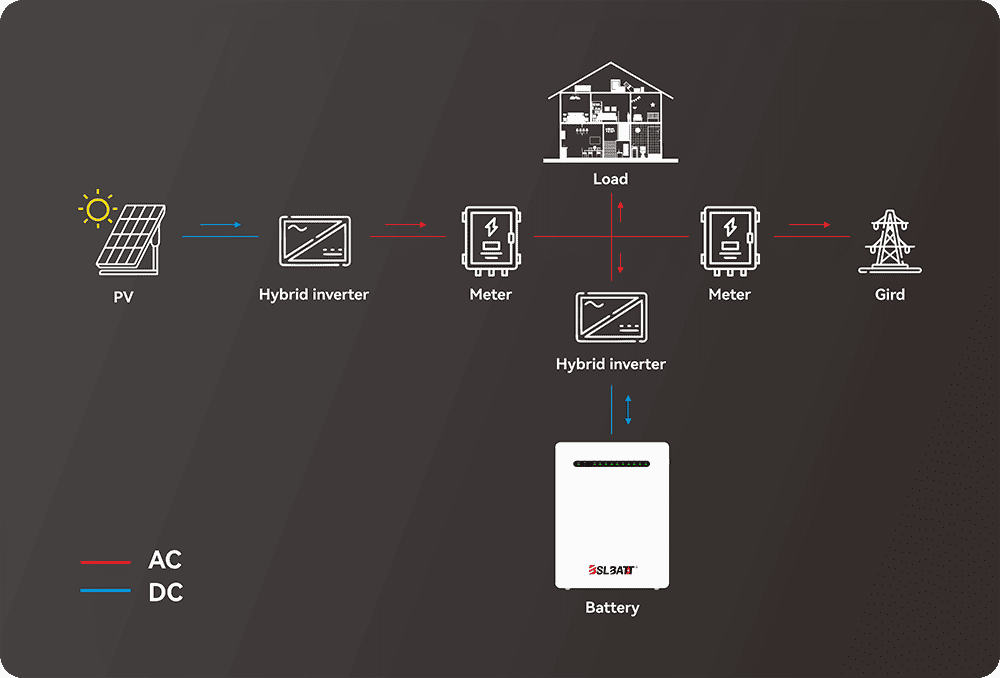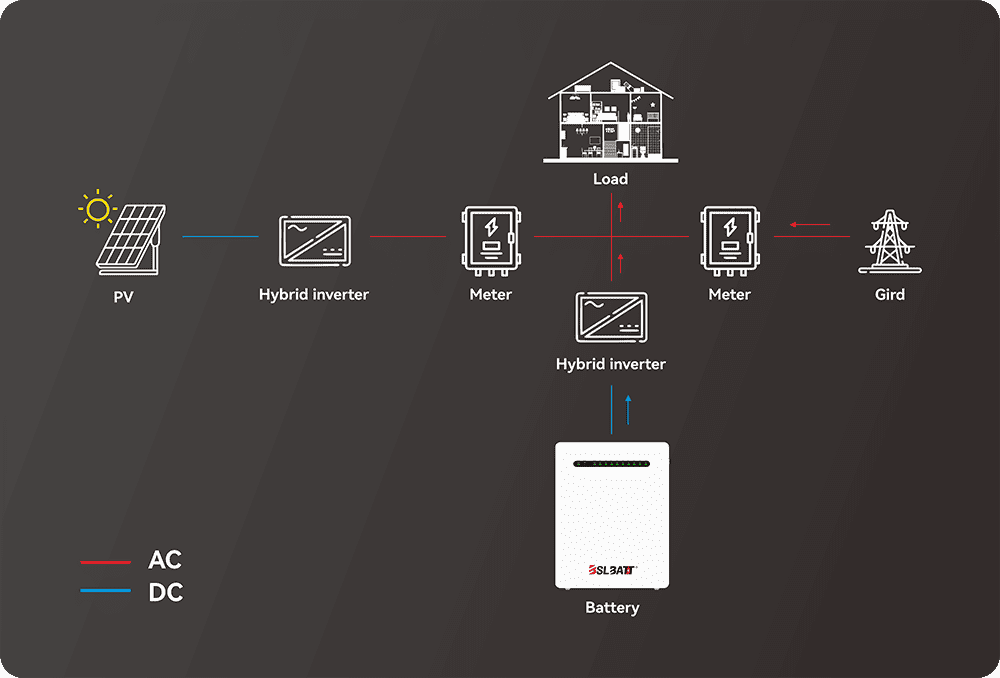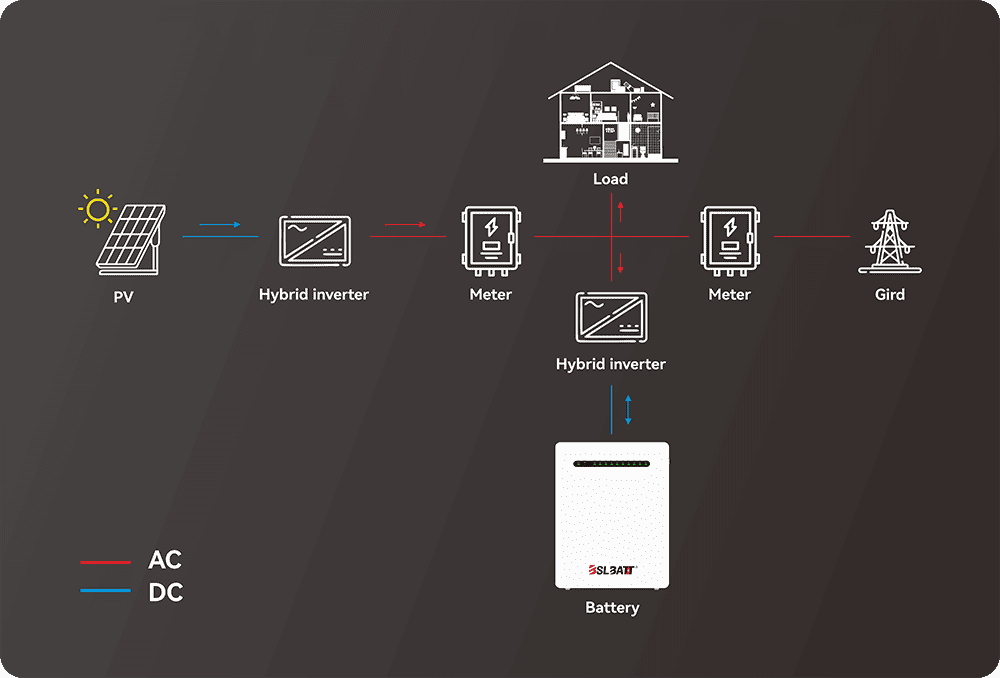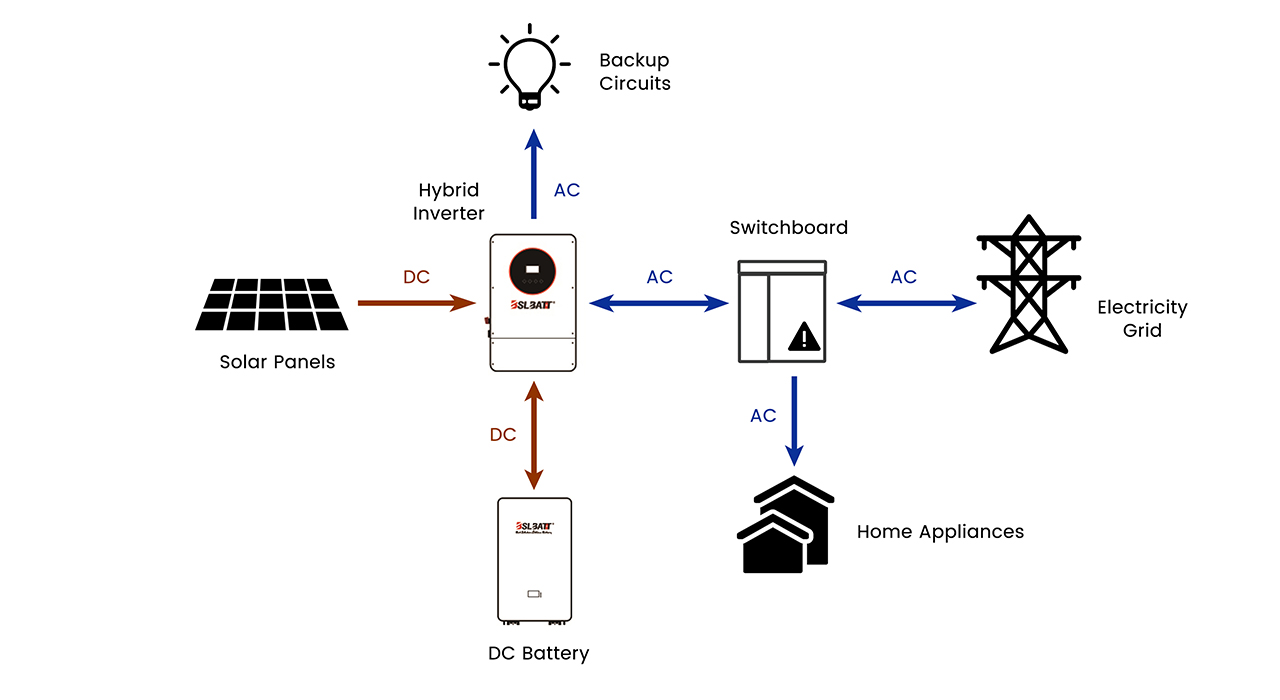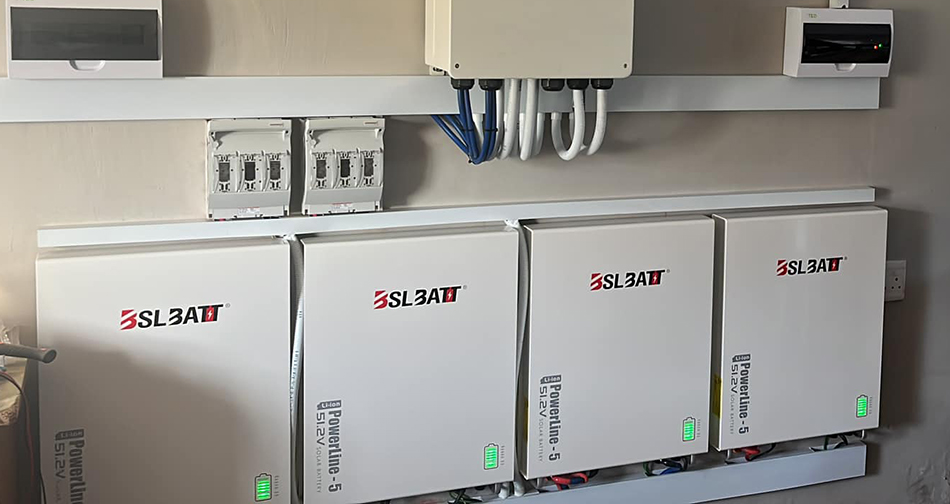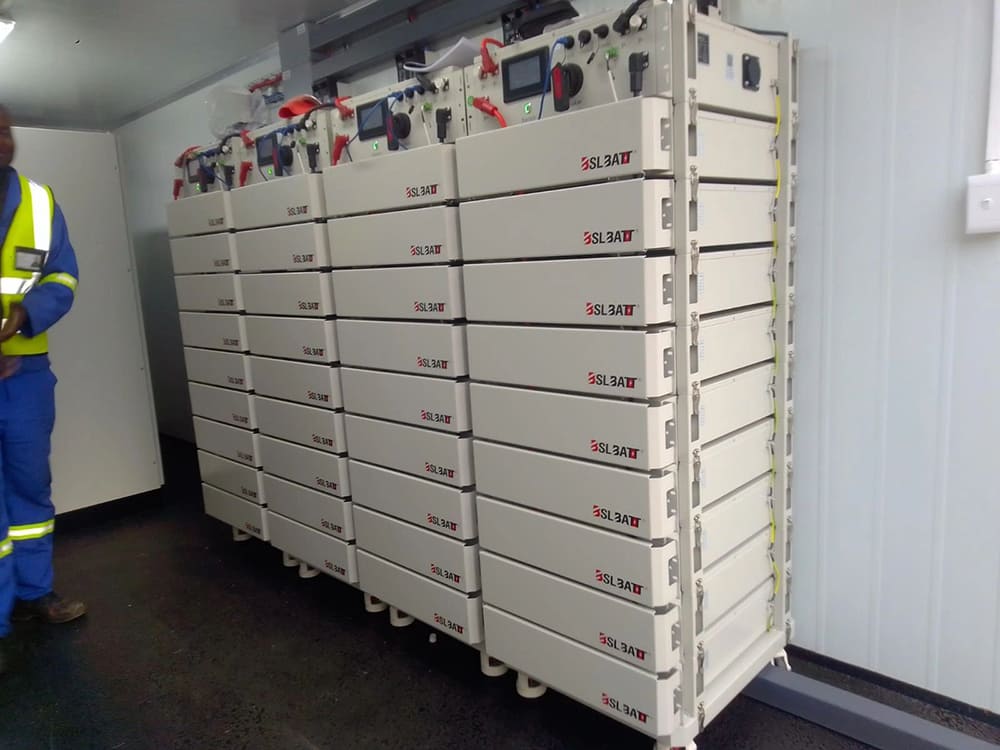Bay avni ou kouran: Poukisa depo enèji solè enpòtan
Panno solè yo (sistèm fotovoltaik oubyen PV) revolisyone fason nou pwodui elektrisite, yo ofri yon sous enèji pwòp e renouvlab dirèkteman sou do kay nou yo. Sepandan, enèji solè a gen yon defi natirèl: panno yo pwodui elektrisite sèlman lè solèy la ap klere. Kisa k ap pase lannwit, oubyen lè syèl la twò nwa? E lè gen pann kouran nan rezo a? Entèmitans sa a souvan vle di ou dwe konte sou rezo tradisyonèl la ankò, sa ki limite tout potansyèl envestisman solè ou a.
Se la sistèm batri PV a antre an jwèt. Imajine w ap kaptire enèji solè anplis, ki pa itilize, ke panno ou yo pwodui pandan lè lajounen pik yo epi konsève l pou pita. Se egzakteman sa yon sistèm depo enèji solè pèmèt ou fè. Li chanje tout bagay pou endepandans ak efikasite enèji. Gid sa a pral fè w konprann tout sa ou bezwen konnen sou sistèm batri PV yo: kisa yo ye, kijan yo fonksyone, konpozan yo, benefis yo, ak konsiderasyon kle yo.
Definisyon Sistèm Batri PV a: Pi lwen pase Panno Solè yo
Ki sa li ye egzakteman?
Senpleman, yon sistèm batri PV konbine panno solè estanda ak yon inite depo batri. Pandan panno solè ou yo konvèti limyè solèy la an elektrisite (kouran DC), batri a estoke nenpòt elektrisite anplis ke kay ou a pa itilize imedyatman. Enèji sa a ki estoke a ka itilize pita, tankou pandan aswè a, nan mitan lannwit, oswa kòm enèji sekou lè rezo elektrik la koupe.
Sa a fondamantalman diferan de yon sistèm solè fotovoltaik estanda ki konekte ak rezo elektrik la san depo. Nan sistèm sa yo, nenpòt enèji solè anplis ki pwodui anjeneral voye tounen nan rezo elektrik la (souvan pou kredi, ke yo rele net metering). Yon sistèm batri fotovoltaik bay priyorite a estoke enèji anplis sa a pou pwòp itilizasyon ou an premye, maksimize otonomi ou.
Konprann Tèm Kle yo
PV (Fotovoltaik):Teknoloji yo itilize nan panno solè pou konvèti limyè solèy la dirèkteman an elektrisite.
Depo Batri:Eleman ki estoke elektrisite DC ki pwodui pa panno solè yo pou itilizasyon pita.
Kalite Sistèm ak Pil:
- Griy-Lye:Konekte ak rezo elektrik la. Yon sistèm batri fotovoltaik la estoke enèji pou pita, sa ki diminye depandans sou rezo a epi potansyèlman bay yon backup.
- Ki pa sou rezo a:Totalman endepandan de rezo elektrik la. Pil yo esansyèl pou estoke enèji pou itilizasyon kontinyèl.
- Ibrid:Konekte sou griy la men ak kapasite pou batri backup, sa ki ofri pi bon nan tou de mond yo.
Kijan yon sistèm batri fotovoltaik fonksyone? (Lajounen, lannwit ak pann kouran)
Prensip debaz la: Sik chaj ak egzeyat
Sistèm nan jere koule enèji a avèk entèlijans, baze sou pwodiksyon solè, bezwen enèji kay la, ak eta chaj batri a. Li fonksyone nan sik chaj ak dechaj diferan.
Senaryo 1: Jou Solèy – Gwo Pwodiksyon
Panno solè yo pwodui elektrisite DC.
Elektrisite sa a bay aparèy ak chaj lakay ou kouran dirèkteman (apre konvèsyon an AC pa envèstisè a).
Nenpòt elektrisite solè anplis la sèvi pou chaje batri a.
Si batri a chaje nèt epi bezwen kay ou a satisfè, ou ka ekspòte plis kouran anplis nan rezo a (selon paramèt sistèm yo ak akò sèvis piblik yo).
Senaryo 2: Lannwit oswa Solèy ki fèb
Pano solè yo pa pwodui anpil oswa pa pwodui okenn elektrisite.
Enèji ki estoke nan batri a dechaje (konvèti an kouran AC) pou bay chaj kay ou a kouran.
Si batri a vin vid oswa demann enèji ou depase kapasite pwodiksyon batri a, sistèm nan otomatikman pran enèji ki nesesè a nan rezo elektrik la.
Senaryo 3: Pann kouran nan griy la
Sistèm nan detekte pann griy la.
Si li fèt pou kouran sekou, li dekonekte otomatikman nan griy la (li rele zile) pou sekirite.
Apre sa, li itilize enèji batri ki estoke a pou bay sikui/chaj esansyèl pre-chwazi lakay ou kouran (tankou limyè, frijidè, Wi-Fi). Dire a depann de kapasite batri a ak gwosè chaj la.
Anatomi yon Sistèm Batri PV: Eksplikasyon sou Konpozan Kle yo
Yon sistèm batri PV gen plizyè eleman prensipal k ap travay ansanm:
Panno Solè (Modil PV):Kaptire limyè solèy la epi konvèti li an elektrisite DC.
Batri Solè:Sere enèji DC a. Sa a se kè sistèm depo a. Diferan pwodui chimik ak kapasite disponib.
Envèsè(yo):Konvèti elektrisite DC (ki soti nan panno/batri) an elektrisite AC (ki itilize pa aparèy kay yo). Envèstisè ibrid yo komen nan sistèm batri paske yo ka jere koule enèji ki soti nan panno yo, batri a, ak griy la an menm tan. Gen kèk sistèm ki ka itilize envèstisè separe pou panno yo ak batri a (kouplaj AC). (Sijesyon lyen entèn: Lyen pou yon paj ki eksplike envèstisè solè yo)
Sistèm Jesyon Batri (BMS):Yon sistèm elektwonik entegre nan pake batri a ki kontwole eta li (tanperati, vòltaj, chaj), pwoteje li kont twòp chaj/dechaje, epi optimize pèfòmans ak dire lavi li.
Kontwolè Chaj (Souvan entegre, enpòtan pou kèk sistèm):Regle kouran DC ki soti nan panno yo pou chaje batri a san danje, anpeche twòp chaj, sitou enpòtan nan konfigirasyon ki konekte ak DC oswa ki pa konekte sou griy la. Souvan entegre nan envèstisè ibrid.
Sistèm siveyans:Lojisyèl (anjeneral yon aplikasyon oswa yon pòtal entènèt) ki pèmèt pwopriyetè kay yo swiv pwodiksyon enèji, konsomasyon, eta batri ak pèfòmans sistèm an tan reyèl.
Ki kalite pil ki pi komen nan sistèm PV yo?
Batri a se yon chwa enpòtan. De prensipal kalite yo itilize jodi a se:
Lityòm-Ion (Li-ion): Chwa Popilè a
Sou-tip:Souvan li se Lityòm Fè Fosfat (LFP oubyen LiFePO4) ki konnen pou sekirite ak lonjevite li, epi Nikèl Manganèz Kobalt (NMC) ki konnen pou dansite enèji li.
Avantaj:Dansite enèji ki wo (plis depo nan mwens espas), dire lavi ki pi long (plis sik chaj), pi gwo pwofondè dechaj (DoD - itilize plis enèji ki estoke), gwo efikasite, jeneralman pa bezwen antretyen.
Dezavantaj:Pri inisyal ki pi wo konpare ak plon-asid.
Plon-Asid: Opsyon Tradisyonèl la
Kalite:Inonde (bezwen antretyen - ajoute dlo distile) ak sele (AGM/Jèl - pa bezwen antretyen).
Avantaj:Pri inisyal ki pi ba, teknoloji ki pwouve efikasite li.
Dezavantaj:Dire lavi ki pi kout, DoD ki pi ba (pa ka itilize otan kapasite ki estoke san domaj), pi lou/pi ankonbran, pi ba efikasite, ka bezwen vantilasyon (inonde).
Pil solè BSLBATT yo sitou baze sou solisyon nwayo depo LiFePO4 ki soti nan 5 pi gwo manifaktirè LiFePO4 nan mond lan tankou EVE, REPT.
Faktè kle pou konparezon:
Kapasite (kWh):Konbyen enèji batri a ka estoke.
Puisans Nominal (kW):Konbyen puisans batri a ka bay alafwa (detèmine konbyen/ki aparèy li ka fè fonksyone an menm tan).
Pwofondè Egzeyat (DoD):Pousantaj kapasite total ki ka itilize san danje (pa egzanp, 90% DoD vle di ou ka itilize 9kWh nan yon batri 10kWh). Pi wo a pi bon.
Efikasite ale-retou (%):Enèji deyò vs enèji antre. Pi wo vle di mwens pèt enèji pandan chaj/dechaj.
Dire lavi (Sik / Ane):Konbyen fwa batri a ka chaje/dechaje anvan kapasite li diminye anpil. Souvan garanti a se pou yon kantite ane oswa sik.
Garanti:Enpòtan pou pwoteje envestisman ou. Gade ane ki kouvri, sik garanti, ak kapasite fen garanti a.
Sekirite:Chèche sètifikasyon (tankouUL / IECestanda). Anjeneral, yo konsidere LFP kòm trè an sekirite.
Pri:Konsidere pri inisyal la vs valè pou tout lavi a ($/kWh ki estoke pandan tout dire lavi li).
Ki vòltaj yon batri PV?
Lè n ap pale de pil PV, "vòltaj" pa yon sèl chif fiks.Sa depann de chimi batri a, kijan chak selil batri yo konfigire nan yon pake, ak objektif konsepsyon jeneral sistèm depo enèji solè a. Men sa ou bezwen konnen:
Vòltaj Nominal: Sa a se vòltaj referans ki souvan itilize pou klase pil oswa sistèm.
Sistèm Vòltaj ki pi ba (Istorikman komen):Sistèm tradisyonèl ki pa konekte ak rezo elektrik la oubyen sistèm ki pi piti yo souvan itilize vòltaj nominal tankou 12V, 24V, oubyen 48V DC. Pil plon-asid yo souvan disponib nan konfigirasyon vòltaj sa yo. Gen kèk sistèm modilè ityòm-ion ki fonksyone tou nan...51.2Vseri, li te ye pou sekirite relatif li yo ak konpatibilite li ak anpil envèstisè hors-grid.
Sistèm ki gen pi gwo vòltaj (tandans modèn):Pifò sistèm batri ityòm-ion rezidansyèl modèn ki konekte ak rezo elektrik yo fonksyone ak vòltaj DC siyifikativman pi wo, souvan sòti nan 200V rive nan 800V DC, ak anviwon 400V DC ki byen komen.
Vòltaj Selil vs Vòltaj Sistèm:
Chak selil batri gen yon vòltaj pi ba anpil (pa egzanp, yon selil LiFePO4 gen yon vòltaj nominal 3.2V).
Pou rive nan vòltaj sistèm ki nesesè a (tankou 48V oswa 400V), plizyè selil konekte an seri (vòltaj yo adisyone) nan yon modil oswa yon pake batri. Konekte modil yo an paralèl ogmante kapasite total la (Ah/kWh) pandan y ap kenbe vòltaj la menm jan an.
Poukisa vòltaj enpòtan?
Efikasite:Sistèm ki gen vòltaj ki pi wo yo jeneralman fè eksperyans mwens pèt enèji rezistif nan fil elektrik pou menm kantite transfè pouvwa a (Puisans = Vòltaj x Kouran). Sa ka vle di yon ti pi bon efikasite sistèm an jeneral.
Pri Fil elektrik:Vòltaj ki pi wo a pèmèt yon kouran ki pi ba, sa vle di yo ka itilize fil kwiv ki pi mens (e souvan mwens chè) ant batri a ak envèstisè ibrid la.
Konpatibilite Envèstisè:Vòltaj batri a dwe konpatib ak seri vòltaj antre DC varyateur ibrid ki konekte a. Batri vòltaj wo yo asosye ak varyateur vòltaj wo yo, epiPil 51.2Vpè ak envèstisè 51.2V.
Sekirite ak Enstalasyon:Sistèm ki gen vòltaj ki pi wo (jeneralman >60V DC) mande pwotokòl sekirite ak pwosedi manipilasyon ki pi strik pandan enstalasyon ak antretyen, souvan kòd elektrik yo egzije sa. Se sèlman pwofesyonèl kalifye ki ta dwe manipile yo.
Ki vòltaj ki kòrèk la?
Pou kay modèn ki konekte ak rezo elektrik la k ap chèche depo enèji efikas ak backup,sistèm ityòm-ion ki gen gwo vòltaj (pa egzanp, ~400V)yo de pli zan pli estanda a, yo byen mache ak envèstisè ibrid efikas.
Pou pi piti aplikasyon ki pa konekte ak rezo elektrik la, RV, oswa amelyorasyon sistèm espesifik ki egziste deja, sistèm 48V yo (tou de ityòm ak plon-asid) rete enpòtan epi yo lajman sipòte.
Finalman, vòltaj espesifik sistèm batri PV ou a pral detèmine pa konsepsyon manifakti a ak konpatibilite li ak envèstisè ou chwazi a ansanm ak achitekti sistèm nan an jeneral. Lè w ap konpare sistèm yo, konprann si se yon sistèm "vòltaj ba" (jeneralman 48V) oswa "vòltaj wo" ede nan evalye karakteristik ak konpatibilite li yo.
Gade atik la sou Pil Vòltaj Segondè vs Pil Vòltaj Ba.
Planifikasyon Envestisman ou: Konsiderasyon Enpòtan Anvan Achte
Envesti nan yon sistèm batri fotovoltaik mande yon planifikasyon atansyon:
Dimansyonman Sistèm ou an:Pa twò gwo ni twò piti. Gwosè batri a (kWh) depann de konsomasyon enèji ou chak jou an mwayèn, gwosè sistèm solè a (kW), sa ou vle sove pandan pann kouran an, ak objektif ou yo (ekonomi maksimòm vs sove debaz). Yon enstalatè pwofesyonèl ka ede kalkile sa.
Konprann Pri yo:Pran an kont pri batri a li menm, envèstisè a (si w ap amelyore/ibrid), travay enstalasyon an, amelyorasyon potansyèl panèl elektrik la, ak pèmi yo. Mande enfòmasyon sou pri total enstalasyon an ak ekonomi potansyèl alontèm yo (Retou sou Envestisman - ROI).
Jwenn Enstalatè Kalifye:Sa a enpòtan anpil pou sekirite ak pèfòmans. Chèche enstalatè ki gen eksperyans epi ki sètifye (pa egzanp, sètifikasyon NABCEP Ozetazini) ki gen bon evalyasyon ak eksperyans espesifik nan sistèm depo batri.
Garanti yo enpòtan:Li ti lèt yo. Konprann dire garanti a (an ane), garanti sik lavi a, ak pousantaj kapasite garanti nan fen garanti a. Souvan gen garanti separe pou batri a, envèstisè a, ak travay enstalasyon an.
Kote Enstalasyon ak Antretyen:Pil yo bezwen tanperati ak espas espesifik pou fonksyone. Konsidere plasman yo (garaj, chanm sèvis, deyò). Pifò pil ityòm-ion modèn yo mande ti kras oswa pa bezwen okenn antretyen, kontrèman ak pil plon-asid ki inonde yo.
Navige Règleman ak Ankourajman:Tcheke kòd konstriksyon lokal yo, egzijans entèkoneksyon sèvis piblik yo (pèmisyon pou konekte), ak ankourajman finansye ki disponib yo. Sa yo ka gen yon enpak siyifikatif sou pri a (pa egzanp,Kredi Taks Federal pou Envestisman nan Solè Etazini (ITC)souvan aplike pou pil ki chaje ak enèji solè, plis rabè leta/lokal).
Sistèm Batri PV vs. Solè Konekte sou Griy Estanda: Ki Diferans ki genyen?
| Karakteristik | Sistèm PV estanda ki konekte ak griy la | Sistèm PV ak Depo Batri |
|---|---|---|
| Depo Enèji | Non (ekspòtasyon depase) | Wi (estoke depase) |
| Pouvwa Sekou | Non (fèmen lè gen pann kouran) | Wi (si li fèt pou backup) |
| Oto-Konsomasyon | Modere | Segondè |
| Depandans sou griy | Modere-Segondè | Ba-Modere |
| Konpleksite | Pi ba | Pi wo |
| Pri Inisyal | Pi ba | Pi wo |
Kesyon yo poze souvan (FAQ) sou sistèm batri fotovoltaik yo
K1: Èske mwen ka ajoute yon pil nan sistèm solè mwen deja genyen an?
A: Wi, souvan ou kapab atravè "kouplaj AC" kote yo ajoute yon batri ak pwòp envèstisè li ansanm ak enstalasyon solè ou deja genyen an. Yon pwofesyonèl bezwen verifye konpatibilite a. Kouplaj DC (pataje yon envèstisè) ka mande pou ranplase envèstisè ki deja egziste a ak yon modèl ibrid.
K2: Konbyen tan pil solè yo dire anjeneral?
A: Dire lavi a depann de kalite, itilizasyon, ak kondisyon yo. Pil ityòm-ion modèn yo (sitou LFP) souvan garanti pou 10-15 ane oswa yon kantite sik espesifik (pa egzanp, 6,000-10,000 sik), epi yo ka potansyèlman dire pi lontan. Pil plon-asid yo tipikman dire 3-7 ane.
K3: Konbyen yon sistèm batri solè lakay koute an mwayèn?
A: Pri yo varye anpil selon gwosè (kWh), mak, kalite, ak konpleksite enstalasyon an. Si w enkli enstalasyon an, atann pri yo ap varye ant $800 ak $1,500+ pou chak kWh kapasite depo (apati kòmansman 2024, tcheke pri aktyèl yo). Ankourajman yo ka diminye sa anpil.
K4: Èske yon batri solè vo li si mwen gen net metering?
A: Sa depann. Si kredi nèt pou mete yo jenere (valè 1:1), benefis ekonomi bòdwo a ka redwi. Sepandan, pil yo toujou bay kouran backup, ede evite chaj Lè-Itilizasyon ki wo, epi ogmante oto-konsomasyon, ki gen valè pi lwen pase kredi nèt pou mete yo. Pwopozisyon valè a ogmante si règleman nèt pou mete yo vin mwens favorab.
K5: Konbyen antretyen pil solè yo bezwen?
A: Pil ityòm-ion modèn yo pa bezwen prèske okenn antretyen. Pil plon-asid (sitou kalite ki inonde) bezwen verifikasyon, netwayaj ak ranpli dlo distile detanzantan. Enstalatè yo ka konseye sou nenpòt rekòmandasyon espesifik manifakti a.
K6: Èske sistèm batri PV yo an sekirite?
A: Lè pwofesyonèl kalifye yo enstale sistèm batri fotovoltaik yo kòrèkteman lè yo itilize ekipman sètifye (tankou pil ak envèstisè ki nan lis UL), yo trè an sekirite. Chimi fosfat ityòm fè (LFP) la patikilyèman byen koni pou estabilite tèmik li ak pwofil sekirite li. Bon enstalasyon ak respè kòd yo enpòtan anpil.
Konklizyon: Èske yon sistèm batri PV se bon chwa pou ou?
Yon sistèm batri PV reprezante yon gwo pa nan direksyon kontwòl enèji, ekonomize lajan, ak rezistans. Lè w estoke enèji gratis ki pwodui pa panno solè w yo, ou ka bay kay ou kouran lontan apre solèy la fin kouche, diminye anpil depandans ou sou rezo a, epi kenbe limyè yo limen pandan pann kouran.
Malgre ke envestisman okòmansman an pi wo pase yon sistèm solè estanda, benefis yo - patikilyèman endepandans enèji, ekonomi siyifikatif alontèm (sitou ak ogmantasyon pri sèvis piblik oswa tarif TOU), ak pouvwa backup ki gen anpil valè - fè li yon chwa konvenkan pou anpil pwopriyetè kay.
Evalye modèl itilizasyon enèji ou yo (Gade kalkilatris batri solè nou an), dezi ou genyen pou kouran sekou, tarif ak règleman sèvis piblik lokal ou yo, ak ankourajman ki disponib yo. Si maksimize envestisman solè ou a epi sekirize ekipman pou kouran lakay ou se priyorite, yon sistèm batri fotovoltaik se pwobableman yon ekselan chwa pou lavni enèji ou.
Dat piblikasyon: 23 avril 2025










